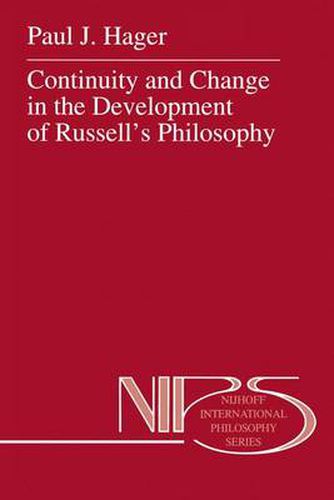Readings Newsletter
Become a Readings Member to make your shopping experience even easier.
Sign in or sign up for free!
You’re not far away from qualifying for FREE standard shipping within Australia
You’ve qualified for FREE standard shipping within Australia
The cart is loading…






This title is printed to order. This book may have been self-published. If so, we cannot guarantee the quality of the content. In the main most books will have gone through the editing process however some may not. We therefore suggest that you be aware of this before ordering this book. If in doubt check either the author or publisher’s details as we are unable to accept any returns unless they are faulty. Please contact us if you have any questions.
The general view of Russell’s work among philosophers has been that repeatedly, during his long and distinguished career, crucial changes of mind on fundamental points were significant enough to cause him to successively adopt a diversity of radically new philosophical positions. Thus, Russell is seen to have embraced and then abandoned, amongst others, neo-Hegelianism, Platonic realism, phenomenalism and logical atomism, before settling finally on a form of neutral monism that philosophers have generally found to be incredible. However, in recent years there have been signs of increasing awareness that the extent to which Russell was prone to change philosophical position may have been greatly exaggerated. This book represents a detailed attempt to trace the fundamental unity that lies within all of Russell’s philosophical work, as well as the reasons behind those limited orderly changes that did, in fact, occur within it. The main thesis of the book is that there is a lot more continuity in Russell’s philosophy than has been usually acknowledged, and that the major changes that do occur are much more orderly than Russell’s reputation for erratically changing his views allows. Drawing on a wide selection of Russell’s own statements, a general account of Russellian analysis is developed which shows it to have a highly organized structure, which he consistently applies throughout all of his post-idealist philosophizing. This book is addressed primarily to serious students of Russell’s philosophy, and is suitable for use in both postgraduate and undergraduate courses on Russell’s philosophy generally, on specific aspects of his work, or on analytic philosophy in the 20th century. However, the book is written clearly enough to be read by the many general readers interested in finding out more about Russell’s philosophy.
$9.00 standard shipping within Australia
FREE standard shipping within Australia for orders over $100.00
Express & International shipping calculated at checkout
This title is printed to order. This book may have been self-published. If so, we cannot guarantee the quality of the content. In the main most books will have gone through the editing process however some may not. We therefore suggest that you be aware of this before ordering this book. If in doubt check either the author or publisher’s details as we are unable to accept any returns unless they are faulty. Please contact us if you have any questions.
The general view of Russell’s work among philosophers has been that repeatedly, during his long and distinguished career, crucial changes of mind on fundamental points were significant enough to cause him to successively adopt a diversity of radically new philosophical positions. Thus, Russell is seen to have embraced and then abandoned, amongst others, neo-Hegelianism, Platonic realism, phenomenalism and logical atomism, before settling finally on a form of neutral monism that philosophers have generally found to be incredible. However, in recent years there have been signs of increasing awareness that the extent to which Russell was prone to change philosophical position may have been greatly exaggerated. This book represents a detailed attempt to trace the fundamental unity that lies within all of Russell’s philosophical work, as well as the reasons behind those limited orderly changes that did, in fact, occur within it. The main thesis of the book is that there is a lot more continuity in Russell’s philosophy than has been usually acknowledged, and that the major changes that do occur are much more orderly than Russell’s reputation for erratically changing his views allows. Drawing on a wide selection of Russell’s own statements, a general account of Russellian analysis is developed which shows it to have a highly organized structure, which he consistently applies throughout all of his post-idealist philosophizing. This book is addressed primarily to serious students of Russell’s philosophy, and is suitable for use in both postgraduate and undergraduate courses on Russell’s philosophy generally, on specific aspects of his work, or on analytic philosophy in the 20th century. However, the book is written clearly enough to be read by the many general readers interested in finding out more about Russell’s philosophy.